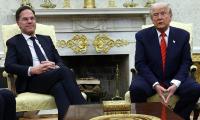Since the end of the cold war, the US has relied more on aggressive economic statecraft to advance its foreign policy goals. Under the Trump administration, this approach has become more acute.
From applying direct economic sanctions on Iran and North Korea, and pursuing reckless tariffs against allies such as Canada, Mexico and EU and strategic rival China, Trump is going on a rampage without realising that it is undermining its global position.
The recent trade war with China is more than a war of words and tariff. Mike Pence, the vice president of the US, has declared it a new ‘cold war’ and Henry Paulson, former US secretary of treasury, has warned of the risk of an ‘economic iron curtain’ if tensions do not de-escalate. The Sino-US economic engagement is going in reverse. The Trump administration has imposed 10 percent tariffs on Chinese imports worth $200 billion, and further threatened to increase tariffs to 25 percent on imports worth $267 billion in 2019, if both countries fail to strike a deal.
Apparently the purpose of the tariffs imposed by Trump is mani-fold. For some analysts, it has an economic objective aimed at reducing growing trade deficit, protecting jobs and boosting local manufacturing to realise the ‘America First’ dream by levelling charges of unfair trade practices on China. Yet a deeper analysis attributes it to pursuing political objectives to check the escalating military influence of China in the South China Sea. America has come to see China as a “strategic rival, a malevolent actor and a rule breaker.” There is great scepticism about the burgeoning role of China in the Belt and Road Initiative (BRI) which is a major determinant of the country’s emerging economic power.
Before imposing further tariffs, American policymakers should seriously consider three questions; firstly whether such a measure violates any international obligation, second if it is legally justifiable under WTO law and third whether it will hurt Chinese trade interests to the benefit of the US.
On the first question, it may be seen that the imposition of tariffs by the Trump administration is a protectionist measure and in direct conflict with the fundamental objectives of the World Trade Organization (WTO) which is based on the premise of liberalisation of trade, whereas the direct purpose of the tariff is to restrict trade.
The preamble to the GATT commits members to enter into “reciprocal and mutually advantageous arrangements directed to the substantial reduction of tariff and other barriers to trade and to elimination of discriminatory treatment in international commerce.” So when tariffs are generally being reduced amongst trading nations in an attempt to reduce trade barriers and promote better market access, increasing tariffs by the US is discriminatory and violates the principle of non-discrimination according to the preamble to the WTO agreement. Although the US was among the founding members of the GATT in 1945, and later on worked earnestly to remove trade barriers, including tariffs, it is ironic that it is becoming a less reliable partner in upholding the global economic order today.
The second question pertains to the legality of imposing tariffs by the US, unilaterally, when it is a member of the multilateral trade system. There are few instances when unilateral action is permitted by WTO law. Unilateral action is recognised, under Article VI of the GATT, where domestic industries are being ‘materially injured’ because of unfair trading practices, specifically dumping or subsidisation. Trade restrictions may also be imposed, on a discriminatory basis, on account of the national security exception under Article XXI of the GATT. Furthermore, they can be imposed by the members selectively, under Article XX of the GATT, where it is necessary to protect public morals; human or animal health or life; national treasures; or conservation of exhaustible natural resources.
If the US believes that its economic interests are being jeopardised and there is material injury to its domestic manufacturers, it can impose anti-dumping duty and countervailing duties on Chinese exports, as it has frequently done in the past. It can also invoke Article XXI and XX of the GATT to its aid. Other than this, any measure to restrict trade in the form of tariffs, without legal backing, will be arbitrary and constitute unjustifiable discrimination or restriction in trade. And if China chooses to challenge these tariffs at the WTO forum, the US will face formidable legal hurdles to defend its stance.
The tariff war does not appear to hurt Chinese trade interest to the benefit of the US. Acting cautiously, China is hopeful of better economic order for its own development needs. It has demonstrated its future import potential at the China International Import Expo (CIIE) in Beijing, inviting hundreds of organisations from around the world, and pledged lower import tariffs to attract more investment in contrast to the protectionist policy of the US. The recent summits of ASEAN, East Asian Nations in Singapore, and Asia Pacific Economic Cooperation (APEC) in Papua New Guinea have collated the interest of countries from South to East Asia to forge invigorating trade and investment ties with China.
It seems likely that alternate trade, finance and development organisations will emerge to circumvent US domination. The US needs to temper its aggressive approach since the economies of the two major powers are greatly intertwined and they share common responsibility for maintaining the world order.
The writer holds an LLM degree in international economic law from the University of Warwick.
Email: beelam_ramzan@yahoo.com
People of that time believed that an eclipse was a symbol of displeasure of gods
Vertically speaking, dominance of domestic debt in Pakistan’s debt portfolio is haunting
Loss of biodiversity is stark reminder that urban mismanagement is not just infrastructural failure but ecological...
Strong public warning systems can also help ensure quick evacuations in places prone to fires
PPPs in Pakistan's WASH sector face significant regulatory and policy challenges that hinder their effectiveness
Instead, it would have powerful chairman with three-year term, appointed at prime minister’s discretion







